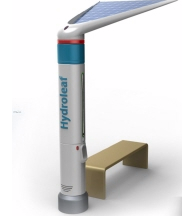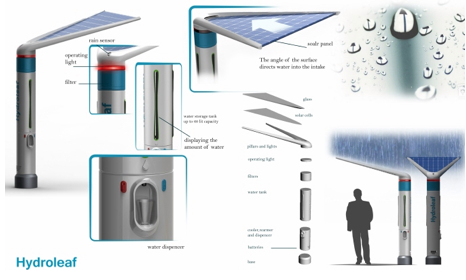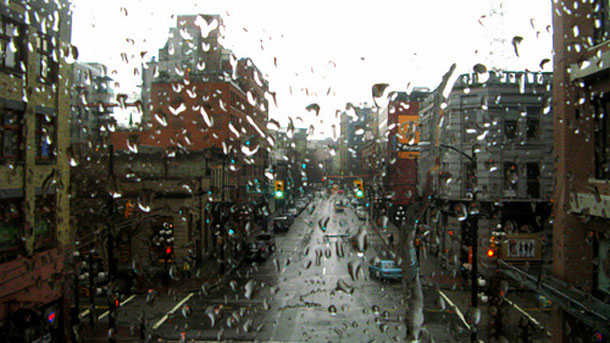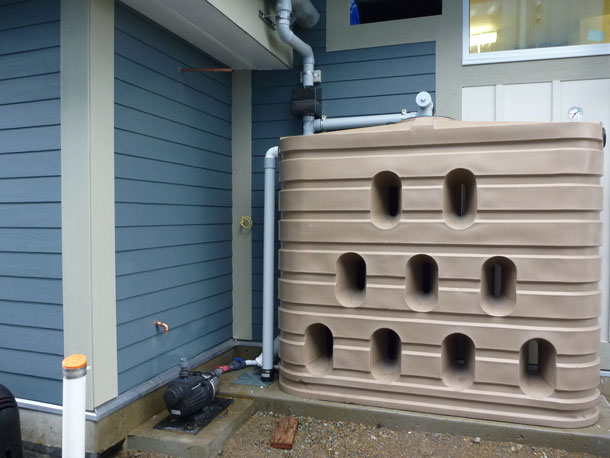Green infrastructure strategies for cheap, effective, and beautiful rainwater management
January 2011
By Katharine Logan

Perhaps my most vivid memory of architecture school comes from a studio in which we built a model of a neighborhood design,and then poured water all over it. The trick was to use enough little pieces of sponge in the model, representing rainwater retention strategies at a variety of scales, so that no water spilled onto the floor. Across North America, regions and municipalities are now trying this trick for real. Why? Because the centuries-old approach of piping water off the land as fast as possible and dumping it into waterways is failing fast.
Each year in Philadelphia, a city with some of the oldest combined storm and sewer infrastructure in North America, billions of gallons of sewage over-flow from 164 outfalls into the city’s creeks, streams, and rivers during major rainstorms. In Milwaukee, a hospital study shows the number of children with serious diarrhea rising whenever the city’s sewers overflow. Run-off pollution from suburban and agricultural sources threatens New York City’s drinking water supply. And it’s estimated that every twenty-four months, rainwater run-off from the streets of Seattle flushes into Puget Sound a volume of oil equivalent to the Exxon Valdez spill.
Nor is the impact on water quality the full extent of the problem—the effecton water quantity is just as devastating. Conventional engineering practice treats rainwater as a problem to be carried off the land as quickly as possible. Under such circumstances, in a matter of hours pipes dump as much as a hundred times more water per minute into a stream than the stream, whose banks have stabilized over millennia, can accept. This wreaks havoc on fish habitat. In Vancouver, British Columbia, there were once over fifty salmon- and trout-bearing streams—by 2009, there were two.
Patrick Lucey is an aquatic ecologist and urban geographer, and one of the designers of the rainwater management system at South East False Creek, a LEED Platinum-certified neighborhood that served as Vancouver’s 2010 Olympic Village: “In shifting to sustainability by design,” Lucey says, ”we’re really talking about shifting from a 2,000-year-old engineering convention to a fundamentally new approach to municipal infrastructure.” This approach is a form of biomimicry, a system based on nature’s implicit design principles, which he sums up in three steps: capture, store, beneficial use.
Starting at the rooftops, green roofs at South East False Creek retain and use a varying amount of rainwater, depending on the season. Water that isn’t captured on the roofs is caught in basement cisterns. Until it’s used for landscape irrigation or toilet flushing, water from the cisterns circulates continuously through neighborhood water features. Not only does moving water delight human beings, the movement aerates it and exposes it to sunlight, which keeps it at a level of quality good enough to swim in.
Once it reaches the ground, water at South East False Creek is kept in the open. Streams that were once piped and buried have been brought back into the daylight. Site water makes its way across a variety of permeable and textured surfaces either to a bioswale on the eastern edge of the project or to Hinge Park wetland on the site’s western edge, and from there to False Creek.
Key to the success of South East False Creek’s rainwater system is the difference between total impermeable area and effective impermeable area. The green infrastructure at South East False Creek makes a high-density urban development behave in the watershed like a site with an impermeable area closer to zero. Along False Creek’s rehabilitated shoreline, herring have spawned for the first time in decades. “That’s amazing,” says Lucey, “herring are very sensitive. That must mean you guys got it right.”
A little further south, but still in rain country, Portland, Oregon’s pioneering work in rainwater management has produced some of the most inspiring examples of street edge rain gardens anywhere, winning awards two years in a row from the American Society of Landscape Architects.
The SW 12th Avenue Green Street Project, built in 2005, converts an underutilized stretch of ground between the sidewalk and the street into a series of four planters that capture, slow, and clean street runoff, and allow it to infiltrate into the earth. The planters effectively disconnect SW 12th from the conventional storm system, and handle the street’s 180,000 gallons of rainwater on site. More than that, planted with trees and well-composed plants, and with tumbled concrete pavers defining their place in the street, they’re beautiful.
Similarly, the NE Siskiyou Green Street Project, built in 2003, consists of two curb extensions, familiar as a traffic calming and pedestrian safety strategy, but with curb cuts to allow rain to flow into well-designed plantings behind them. Cheap and simple, the rain gardens manage NE Siskiyou’s day-to-day rainwater on site, and are projected to manage 85 percent of a 25-year storm.
As well as the technical success and aesthetic appeal of sustainable rainwater infrastructure, its cost-effectiveness warms its welcome with municipalities struggling to maintain outdated and overburdened pipe infrastructure. In Philadelphia, upgrading the existing combined storm and sewer system would cost over $10 billion. “There is no way in the world that we could ever pay for something like that,” Philadelphia mayor Michael Nutter told an audience at the recent “Charting New Waters” conference in Washington, D.C. Instead, Philadelphia’s Green City Clean Waters program proposes to spend $1.6 billion to achieve a safe and sustainable rainwater management system using green infrastructure.
Philadelphia has set a goal of transforming at least a third of existing impervious cover in its combined sewer system drainage area over the next two decades into “greened acres” that will filter or store the first inch of each rainfall. That first inch, it turns out, is enormously significant. Except in Florida, most rainstorms in North America deliver less than an inch of rain per day. So if a site can infiltrate an inch a day, it will treat 80 to 90 percent of its rain on site.
An early adopter of green rainwater strategies, Philadelphia has already completed projects to reduce the imperviousness of its public domain, including the creation of raised bed vegetable gardens and rain gardens in school parking lots, tree trenches in road meridians, bioswales in parking lots, and sidewalk infiltration planters modeled after the Portland examples. Neighborhood basketball players particularly appreciate Philadelphia’s pervious asphalt basketball courts, which are dry enough to play on much sooner after rainfall than regular courts.
Not only is Philadelphia implementing the first inch strategy in the public realm, it is requiring it for any private development that disturbs more than 15,000 square feet of earth. As a result, rainwater management is integrated early in the zoning and building permit process.
The city provides information and support to homeowners wanting to collect roof runoff in rain barrels, disconnect downspouts to direct runoff to pervious areas, or use site slopes to create rain gardens. To encourage retrofitting commercial and residential property for on-site rainwater management, Philadelphia is phasing in an initiative, which separates stormwater billing from the water bill, and ties it to the impervious cover of the site.
The public response to Philadelphia’s green infrastructure agenda has been overwhelmingly positive (92 percent), according to the city’s water department. In response to its Green Streets Survey, the department heard the public say, “I love the idea! It would make us healthier and happier all around,” and “we are proud to be a model neighborhood.”
Katharine Logan is an architecturally trained and LEED-accredited writer based in British Columbia
This article appeared in the January 2011 print issue of GreenSource Magazine.
 SKYWATER
SKYWATER






 DANGER: Drinking this toilet water could be hazardous to your health.
DANGER: Drinking this toilet water could be hazardous to your health.



